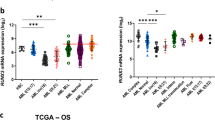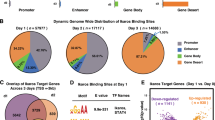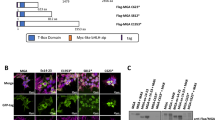Abstract
In T-cell acute lymphoblastic leukemia (T-ALL) the cardiac homeobox gene NKX2-5 (at 5q35) is variously deregulated by regulatory elements coordinating with BCL11B (at 14q32.2), or the T-cell receptor gene TRD (at 14q11.2), respectively. NKX2-5 is normally expressed in developing spleen and heart, regulating fundamental processes, including differentiation and survival. In this study we investigated whether NKX2-5 expression in T-ALL cell lines reactivates these embryonal pathways contributing to leukemogenesis. Among 18 known targets analyzed, we identified three genes regulated by NKX2-5 in T-ALL cells, including myocyte enhancer factor 2C (MEF2C). Knockdown and overexpression assays confirmed MEF2C activation by NKX2-5 at both the RNA and protein levels. Direct interactions between NKX2-5 and GATA3 as indicated by co-immunoprecipitation data may contribute to MEF2C regulation. In T-ALL cell lines LOUCY and RPMI-8402 MEF2C expression was correlated with a 5q14 deletion, encompassing noncoding proximal gene regions. Fusion constructs with green fluorescent protein permitted subcellular detection of MEF2C protein in nuclear speckles interpretable as repression complexes. MEF2C consistently inhibits expression of NR4A1/NUR77, which regulates apoptosis via BCL2 transformation. Taken together, our data identify distinct mechanisms underlying ectopic MEF2C expression in T-ALL, either as a downstream target of NKX2-5, or via chromosomal aberrations deleting proximal gene regions.
This is a preview of subscription content, access via your institution
Access options
Subscribe to this journal
Receive 12 print issues and online access
$259.00 per year
only $21.58 per issue
Buy this article
- Purchase on Springer Link
- Instant access to full article PDF
Prices may be subject to local taxes which are calculated during checkout




Similar content being viewed by others
References
Duboule D . Guidebook to the Homeobox Genes. Oxford University Press: Oxford, 1994, pp 13–23.
Cillo C, Cantile M, Faiella A, Boncinelli E . Homeobox genes in normal and malignant cells. J Cell Physiol 2001; 188: 161–169.
Abate-Shen C . Deregulated homeobox gene expression in cancer: cause or consequence? Nat Rev Cancer 2002; 2: 777–785.
Holland PW . Beyond the Hox: how widespread is homeobox gene clustering? J Anat 2001; 199: 13–23.
Garcia-Fernandez J . The genesis and evolution of homeobox gene clusters. Nat Rev Genet 2005; 6: 881–892.
Soulier J, Clappier E, Cayuela JM, Regnault A, Garcia-Peydro M, Dombret H et al. HOXA genes are included in genetic and biologic networks defining human acute T-cell leukemia (T-ALL). Blood 2005; 106: 274–286.
Nagel S, Kaufmann M, Drexler HG, MacLeod RA . The cardiac homeobox gene NKX2-5 is deregulated by juxtaposition with BCL11B in pediatric T-ALL cell lines via a novel t(5;14)(q35.1;q32.2). Cancer Res 2003; 63: 5329–5334.
Speleman F, Cauwelier B, Dastugue N, Cools J, Verhasselt B, Poppe B et al. A new recurrent inversion, inv(7)(p15q34), leads to transcriptional activation of HOXA10 and HOXA11 in a subset of T-cell acute lymphoblastic leukemias. Leukemia 2005; 19: 358–366.
Hatano M, Roberts CW, Minden M, Crist WM, Korsmeyer SJ . Deregulation of a homeobox gene, HOX11, by the t(10;14) in T cell leukemia. Science 1991; 253: 79–82.
Bernard OA, Busson-LeConiat M, Ballerini P, Mauchauffe M, Della Valle V, Monni R et al. A new recurrent and specific cryptic translocation, t(5;14)(q35;q32), is associated with expression of the Hox11L2 gene in T acute lymphoblastic leukemia. Leukemia 2001; 15: 1495–1504.
De Keersmaecker K, Marynen P, Cools J . Genetic insights in the pathogenesis of T-cell acute lymphoblastic leukemia. Haematologica 2005; 90: 1116–1127.
Graux C, Cools J, Michaux L, Vandenberghe P, Hagemeijer A . Cytogenetics and molecular genetics of T-cell acute lymphoblastic leukemia: from thymocyte to lymphoblast. Leukemia 2006; 20: 1496–1510.
Ferrando AA, Neuberg DS, Staunton J, Loh ML, Huard C, Raimondi SC et al. Gene expression signatures define novel oncogenic pathways in T cell acute lymphoblastic leukemia. Cancer Cell 2002; 1: 75–87.
Ballerini P, Blaise A, Busson-Le Coniat M, Su XY, Zucman-Rossi J, Adam M et al. HOX11L2 expression defines a clinical subtype of pediatric T-ALL associated with poor prognosis. Blood 2002; 100: 991–997.
Watt PM, Kumar R, Kees UR . Promoter demethylation accompanies reactivation of the HOX11 proto-oncogene in leukemia. Genes Chromosomes Cancer 2000; 29: 371–377.
Przybylski GK, Dik WA, Grabarczyk P, Wanzeck J, Chudobska P, Jankowski K et al. The effect of a novel recombination between the homeobox gene NKX2-5 and the TRD locus in T-cell acute lymphoblastic leukemia on activation of the NKX2-5 gene. Haematologica 2006; 91: 317–321.
MacLeod RAF, Nagel S, Kaufmann M, Janssen JW, Drexler HG . Activation of HOX11L2 by juxtaposition with 3′-BCL11B in an acute lymphoblastic leukemia cell line (HPB-ALL) with t(5;14)(q35;q32.2). Genes Chromosomes Cancer 2003; 37: 84–91.
Hansen-Hagge TE, Schafer M, Kiyoi H, Morris SW, Whitlock JA, Koch P et al. Disruption of the RanBP17/Hox11L2 region by recombination with the TCRdelta locus in acute lymphoblastic leukemias with t(5;14)(q34;q11). Leukemia 2002; 16: 2205–2212.
Kennedy MA, Gonzalez-Sarmiento R, Kees UR, Lampert F, Dear N, Boehm T et al. HOX11, a homeobox-containing T-cell oncogene on human chromosome 10q24. Proc Natl Acad Sci USA 1991; 88: 8900–8904.
Nagel S, Scherr M, Kel A, Hornischer K, Crawford GE, Kaufmann M et al. Activation of TLX3 and NKX2-5 in t(5;14)(q35;q32) T-cell acute lymphoblastic leukemia by remote 3′-BCL11B enhancers and coregulation by PU.1 and HMGA1. Cancer Res 2007; 67: 1461–1471.
Lints TJ, Parsons LM, Hartley L, Lyons I, Harvey RP . Nkx-2.5: a novel murine homeobox gene expressed in early heart progenitor cells and their myogenic descendants. Development 1993; 119: 419–431.
Du Y, Spence SE, Jenkins NA, Copeland NG . Cooperating cancer-gene identification through oncogenic-retrovirus-induced insertional mutagenesis. Blood 2005; 106: 2498–2505.
Drexler HG . Guide to Leukemia-Lymphoma Cell Lines. Braunschweig, 2005, (compact disc).
MacLeod RAF, Kaufmann M, Drexler HG . Cytogenetic harvesting of commonly used tumor cell lines. Nat Protoc 2007; 2: 372–382.
MacLeod RAF, Drexler HG . Cytogenetic analysis of cell lines. Methods Mol Biol 2005; 290: 51–70.
Quentmeier H, Zaborski M, Drexler HG . Effects of thrombopoietin, interleukin-3 and the kinase inhibitor K-252a on growth and polyploidization of the megakaryocytic cell line M-07e. Leukemia 1998; 12: 1603–1611.
Nagel S, Burek C, Venturini L, Scherr M, Quentmeier H, Meyer C et al. Comprehensive analysis of homeobox genes in Hodgkin lymphoma cell lines identifies dysregulated expression of HOXB9 mediated via ERK5 signaling and BMI1. Blood 2007; 109: 3015–3023.
Nagel S, Scherr M, Quentmeier H, Kaufmann M, Zaborski M, Drexler HG et al. HLXB9 activates IL6 in Hodgkin lymphoma cell lines and is regulated by PI3K signalling involving E2F3. Leukemia 2005; 19: 841–846.
Liu H, Harris TM, Kim HH, Childs G . Cardiac myocyte differentiation: the Nkx2.5 and Cripto target genes in P19 clone 6 cells. Funct Integr Genomics 2005; 5: 218–239.
Ryan KM, Hendren JD, Helander LA, Cripps RM . The NK homeodomain transcription factor Tinman is a direct activator of seven-up in the Drosophila dorsal vessel. Dev Biol 2007; 302: 694–702.
Guo L, Lynch J, Nakamura K, Fliegel L, Kasahara H, Izumo S et al. COUP-TF1 antagonizes Nkx2.5-mediated activation of the calreticulin gene during cardiac development. J Biol Chem 2001; 276: 2797–2801.
Jay PY, Rozhitskaya O, Tarnavski O, Sherwood MC, Dorfman AL, Lu Y et al. Haploinsufficiency of the cardiac transcription factor Nkx2-5 variably affects the expression of putative target genes. FASEB J 2005; 19: 1495–1497.
von Both I, Silvestri C, Erdemir T, Lickert H, Walls JR, Henkelman RM et al. Foxh1 is essential for development of the anterior heart field. Dev Cell 2004; 7: 331–345.
Olson EN . Gene regulatory networks in the evolution and development of the heart. Science 2006; 313: 1922–1927.
Gajewski K, Kim Y, Lee YM, Olson EN, Schulz RA . D-mef2 is a target for Tinman activation during Drosophila heart development. EMBO J 1997; 16: 515–522.
Gajewski K, Zhang Q, Choi CY, Fossett N, Dang A, Kim YH et al. Pannier is a transcriptional target and partner of Tinman during Drosophila cardiogenesis. Dev Biol 2001; 233: 425–436.
Skerjanc IS, Petropoulos H, Ridgeway AG, Wilton S . Myocyte enhancer factor 2C and Nkx2-5 up-regulate each other's expression and initiate cardiomyogenesis in P19 cells. J Biol Chem 1998; 273: 34904–34910.
Ganga M, Espinoza HM, Cox CJ, Morton L, Hjalt TA, Lee Y et al. PITX2 isoform-specific regulation of atrial natriuretic factor expression: synergism and repression with Nkx2.5. J Biol Chem 2003; 278: 22437–22445.
Han Z, Olson EN . Hand is a direct target of Tinman and GATA factors during Drosophila cardiogenesis and hematopoiesis. Development 2005; 132: 3525–3536.
Choi CY, Lee YM, Kim YH, Park T, Jeon BH, Schulz RA et al. The homeodomain transcription factor NK-4 acts as either a transcriptional activator or repressor and interacts with the p300 coactivator and the Groucho corepressor. J Biol Chem 1999; 274: 31543–31552.
Strizzi L, Bianco C, Normanno N, Salomon D . Cripto-1: a multifunctional modulator during embryogenesis and oncogenesis. Oncogene 2005; 24: 5731–5741.
Kieusseian A, Chagraoui J, Kerdudo C, Mangeot PE, Gage PJ, Navarro N et al. Expression of Pitx2 in stromal cells is required for normal hematopoiesis. Blood 2006; 107: 492–500.
Swanson BJ, Jack HM, Lyons GE . Characterization of myocyte enhancer factor 2 (MEF2) expression in B and T cells: MEF2C is a B cell-restricted transcription factor in lymphocytes. Mol Immunol 1998; 35: 445–458.
Yuki Y, Imoto I, Imaizumi M, Hibi S, Kaneko Y, Amagasa T et al. Identification of a novel fusion gene in a pre-B acute lymphoblastic leukemia with t(1;19)(q23;p13). Cancer Sci 2004; 95: 503–507.
Prima V, Gore L, Caires A, Boomer T, Yoshinari M, Imaizumi M et al. Cloning and functional characterization of MEF2D/DAZAP1 and DAZAP1/MEF2D fusion proteins created by a variant t(1;19)(q23;p13.3) in acute lymphoblastic leukemia. Leukemia 2005; 19: 806–813.
Dodou E, Xu SM, Black BL . mef2c is activated directly by myogenic basic helix-loop-helix proteins during skeletal muscle development in vivo. Mech Dev 2003; 120: 1021–1032.
De Val S, Anderson JP, Heidt AB, Khiem D, Xu SM, Black BL . Mef2c is activated directly by Ets transcription factors through an evolutionarily conserved endothelial cell-specific enhancer. Dev Biol 2004; 275: 424–434.
Dodou E, Verzi MP, Anderson JP, Xu SM, Black BL . Mef2c is a direct transcriptional target of ISL1 and GATA factors in the anterior heart field during mouse embryonic development. Development 2004; 131: 3931–3942.
Patient RK, McGhee JD . The GATA family (vertebrates and invertebrates). Curr Opin Genet Dev 2002; 12: 416–422.
Durocher D, Charron F, Warren R, Schwartz RJ, Nemer M . The cardiac transcription factors Nkx2-5 and GATA-4 are mutual cofactors. EMBO J 1997; 16: 5687–5696.
Oosterwegel M, Timmerman J, Leiden J, Clevers H . Expression of GATA-3 during lymphocyte differentiation and mouse embryogenesis. Dev Immunol 1992; 3: 1–11.
Borghi S, Molinari S, Razzini G, Parise F, Battini R, Ferrari S . The nuclear localization domain of the MEF2 family of transcription factors shows member-specific features and mediates the nuclear import of histone deacetylase 4. J Cell Sci 2001; 114: 4477–4483.
Wu X, Li H, Park EJ, Chen JD . SMRTE inhibits MEF2C transcriptional activation by targeting HDAC4 and 5 to nuclear domains. J Biol Chem 2001; 276: 24177–24185.
Verzi MP, Agarwal P, Brown C, McCulley DJ, Schwarz JJ, Black BL . The transcription factor MEF2C is required for craniofacial development. Dev Cell 2007; 12: 645–652.
He YW . Orphan nuclear receptors in T lymphocyte development. J Leukoc Biol 2002; 72: 440–446.
Starr TK, Jameson SC, Hogquist KA . Positive and negative selection of T cells. Annu Rev Immunol 2003; 21: 139–176.
Youn HD, Sun L, Prywes R, Liu JO . Apoptosis of T cells mediated by Ca2+-induced release of the transcription factor MEF2. Science 1999; 286: 790–793.
Youn HD, Liu JO . Cabin1 represses MEF2-dependent Nur77 expression and T cell apoptosis by controlling association of histone deacetylases and acetylases with MEF2. Immunity 2000; 13: 85–94.
Youn HD, Chatila TA, Liu JO . Integration of calcineurin and MEF2 signals by the coactivator p300 during T-cell apoptosis. EMBO J 2000; 19: 4323–4331.
Winoto A, Littman DR . Nuclear hormone receptors in T lymphocytes. Cell 2002; 109: 57–66.
Hoffmann K, Dixon DN, Greene WK, Ford J, Taplin R, Kees UR . A microarray model system identifies potential new target genes of the proto-oncogene HOX11. Genes Chromosomes Cancer 2004; 41: 309–320.
Gregoire S, Xiao L, Nie J, Zhang X, Xu M, Li J et al. Histone deacetylase 3 interacts with and deacetylates myocyte enhancer factor 2. Mol Cell Biol 2007; 27: 1280–1295.
Zhao M, New L, Kravchenko VV, Kato Y, Gram H, di Padova F et al. Regulation of the MEF2 family of transcription factors by p38. Mol Cell Biol 1999; 19: 21–30.
Lin B, Kolluri SK, Lin F, Liu W, Han YH, Cao X et al. Conversion of Bcl-2 from protector to killer by interaction with nuclear orphan receptor Nur77/TR3. Cell 2004; 116: 527–540.
Luciano F, Krajewska M, Ortiz-Rubio P, Krajewski S, Zhai D, Faustin B et al. Nur77 converts phenotype of Bcl-B, an antiapoptotic protein expressed in plasma cells and myeloma. Blood 2007; 109: 3849–3855.
Real PJ, Cao Y, Wang R, Nikolovska-Coleska Z, Sanz-Ortiz J, Wang S et al. Breast cancer cells can evade apoptosis-mediated selective killing by a novel small molecule inhibitor of Bcl-2. Cancer Res 2004; 64: 7947–7953.
Linette GP, Grusby MJ, Hedrick SM, Hansen TH, Glimcher LH, Korsmeyer SJ . Bcl-2 is upregulated at the CD4+ CD8+ stage during positive selection and promotes thymocyte differentiation at several control points. Immunity 1994; 1: 197–205.
Williams O, Brady HJ . The role of molecules that mediate apoptosis in T-cell selection. Trends Immunol 2001; 22: 107–111.
Krivtsov AV, Twomey D, Feng Z, Stubbs MC, Wang Y, Faber J et al. Transformation from committed progenitor to leukaemia stem cell initiated by MLL-AF9. Nature 2006; 442: 818–822.
Mullican SE, Zhang S, Konopleva M, Ruvolo V, Andreeff M, Milbrandt J et al. Abrogation of nuclear receptors Nr4a3 andNr4a1 leads to development of acute myeloid leukemia. Nat Med 2007; 13: 730–735.
Author information
Authors and Affiliations
Corresponding author
Additional information
Supplementary Information accompanies the paper on the Leukemia website (http://www.nature.com/leu)
Rights and permissions
About this article
Cite this article
Nagel, S., Meyer, C., Quentmeier, H. et al. MEF2C is activated by multiple mechanisms in a subset of T-acute lymphoblastic leukemia cell lines. Leukemia 22, 600–607 (2008). https://doi.org/10.1038/sj.leu.2405067
Received:
Revised:
Accepted:
Published:
Issue Date:
DOI: https://doi.org/10.1038/sj.leu.2405067
Keywords
This article is cited by
-
A novel MEF2C mutation in lymphoid neoplasm diffuse large B-cell lymphoma promotes tumorigenesis by increasing c-JUN expression
Naunyn-Schmiedeberg's Archives of Pharmacology (2020)
-
MEF2C protects bone marrow B-lymphoid progenitors during stress haematopoiesis
Nature Communications (2016)
-
MEF2D/Wnt/β-catenin pathway regulates the proliferation of gastric cancer cells and is regulated by microRNA-19
Tumor Biology (2016)
-
High expression of myocyte enhancer factor 2C (MEF2C) is associated with adverse-risk features and poor outcome in pediatric acute myeloid leukemia: a report from the Children’s Oncology Group
Journal of Hematology & Oncology (2015)
-
Myocyte enhancer factor 2C in hematopoiesis and leukemia
Oncogene (2014)



